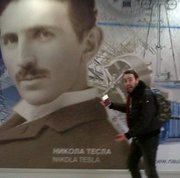Albania's National Museum lets its skeleton out of the closet
Posted: Thursday, 13 January 2011 by Jimmy Christ in Labels: Albania, Communism, TiranaWhen the wall fell, Albania was the skeleton of the missing wife bricked up on the other side. No nation has any (un)favoured status in any imagine hierarchy of oppression, but in the Balkans at least, Communist Albania was in a particularly sad way thanks to Stalinist nostalgia of dictator for life Enver Hoxha, a man determined to party like it was 1949.
At the centre of this bloc party was the National Historic Museum in the Albanian capital of Tirana, a gauche glorification of Hoxha and the Albanian Worker's Party, constructed 1981 in a style that can only be described as 'discount rack Soviet Realism', its contents were of even worse taste, so much so that in 1992 the country's first democratically elected government ordered it torn down.
“Twenty years have passed since the advent of democracy and the museum should objectively represent all the country’s achievements,” Luan Malltezi, the museum director, said to Balkan Insight, promising that it will be “an honest representation of the period.”
"Although the pavilion was a megalomaniacal affair and it politicized some of the items, they did help tell the story of the country’s reconstruction [after the war] and have historic value,” the writer and historian, Moikom Zeqo, said in the same article.
Currently the biggest museum in Albania, the National Historic Museum is one of the capital's main tourist attractions, boasting over 4,000 objects which recount the story of this particular chunk of the land from the Illyrian tribes of antiquity to the grandeur of Albania's 14th Century princes, and ignoring the half a century which shaped modern Albania so profoundly is an act of understandable denial for a people so heavily traumatised, but an act of crass ignorance for history.

